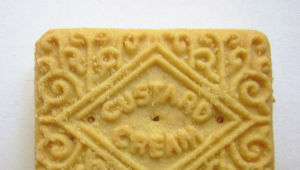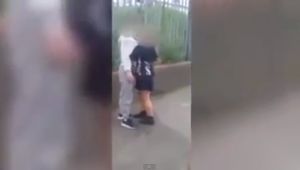1169 and all that...
This Easter, we were treated to a spectacle that used to be commonplace during the Troubles. Beer-bellied men in balaclavas standing under tricolours in graveyards, reading terse, menacing communiqués to small gatherings of hardline Republicans; it could have been 1973 all over again.
To understand why today in the early 21st century, we are still watching news coverage of masked men threatening to assassinate members of the British Royal Family, we are almost inevitably forced to take a history lesson...
Certainly, the Queen’s proposed visit to Ireland in May is a hostage to history; how could it ever be otherwise? It is a hundred years since the Queen’s Grandfather George V sailed into Kingstown (Dun Laoghaire) at the head of a flotilla of gunboats, so for some, this year’s visit has a pleasing, almost geometrically fitting sense of occasion.
However, this being Anglo Irish relations, there is always a spectre at the feast. Another coinciding anniversary for this milestone visit is one that fits rather less comfortably with the agenda of choreographing a new era of detente.
The British head of state arrives in Ireland on 17 May , the anniversary of the Dublin Monaghan Bombings in 1974, which killed 33 people; the highest daily death toll of the entire Troubles. Allegations of British Intelligence involvement in the four no-warning car-bombs have never gone away...
But again, it’s also probably worth remembering that in a personal and immediate way, the Windsor family can empathise with the loss that blighted so many families during the Troubles. Louis Mountbatten was Philip’s uncle and he was, by all accounts, very close to the man assassinated by the IRA in August 1979. Logical consistency aside, on a simple human level, failure to acknowledge that fact would be a disrespect to all the Troubles’ victims.
One could almost pity poor Mrs Windsor’s diary secretary. Imagine the difficulty of working out a time to hold this visit that didn’t upset someone. Trying to find a date for the Queen’s Irish visit must have been a bit like opening the little windows of a grisly advent calendar to find a dead martyr or conflict-related outrage behind each one.
Unlike a lot of traditional Republicans, I would happily support closer diplomatic and even constitutional links with Britain in the pursuit of that cherished goal of a peaceful, united Ireland, particularly if it gave confidence to Northern Ireland’s unionist community.
James Joyce once described history as a nightmare from which he was trying to awake. I feel no nostalgia for the re-emergence of such practices but feel compelled nevertheless to try and put such events in context. How does one explain the madness of the Troubles to an English audience that has no experience and little memory of life under what was effectively martial law?
My first personal experience of the Troubles came in 1975 when my family lived just south of County Fermanagh; one of the Six Irish counties which remain part of the UK. Like a lot of southerners (‘Mexicans’ or ‘Free-Staters’ in local parlance),we regularly crossed the border to do our shopping in Enniskillen.
On one such trip, while I stayed with my father and my mother shopped alone for fashions that hadn’t yet made it south, an incendiary device was set off in a downtown department store. Our biggest worry was that Mum had been caught in the shop which was targeted by the IRA. As we tried to get through the cordoned off town centre in a frantic hunt for my mother, I was searched by the British Army for the first time in my life; I was five years old.
As it turned out, my mother had left the shop shortly before the suspect device was detonated and it’s hard to describe the relief we felt when we found her waiting for us at the car-park. It wasn’t exactly ‘all’s well that ends well’ but we were lucky, there had been no casualties that day. It remains one of my most vivid early memories; the noise, the confusion, the rough shaking hands of the young soldier and the smell of gun-oil from his SLR rifle as he went through my pockets.
This incident probably didn’t even make the local news in Ulster that evening, such was the intensity of the struggle in the early 1970s; if there were no fatalities, there was little coverage.
In Britain, the big date for history scholars is 1066; ours is 1169. That was the year that Henry II sent a group of Norman Knights over to Ireland under the command of Strongbow (Richard de Clare, the Earl of Pembroke) to fight on behalf of an exiled Irish chieftain Diarmuid McMurrough. Henry’s Irish adventure, undertaken with the blessing of Adrian IV (Nicholas Breakspear), England’s only Pope, marked the beginning of a troubled 800-year relationship.
That relationship, at least on an orthodox Republican reading of Anglo-Irish history, has been characterised by ethnic cleansing, bondage (not the fun kind), famine, intermittent bloody rebellion and religious strife.
This rebellion might have been just another doomed insurgency had the British not decided to execute its leaders as traitors. From 1919 to 1921, The War of Independence was fought as a guerrilla campaign by the Irish Volunteers now called for the first time; the Irish Republican Army
For centuries, the Catholic Irish lived as second-class citizens in their own country, with the vast majority never more than a heartbeat from starvation and eviction. It’s when we get to the 19th century however that we really see the roots of the current problem.
The Potato Famine in the 1840s marks the most decisive turning point. Irish Republicans will waste no time in reminding British listeners that food was still being exported from Ireland, often under armed guard even while millions died of hunger and disease.
Following this very Irish holocaust, which was largely a product of English-led economic policies and indifference rather than deliberate design, a new revolutionary movement emerged in the 1850s. The Fenians or Irish Republican Brotherhood (IRB) looked to the growing Irish-American diaspora for support and that is a model that worked right up to the Troubles of the late 20th century.
Back at the end of the 19th century, Irish parliamentarians campaigned for land reform and Home Rule. The land reform movement gave the world a new word when Captain Boycott, a landlord’s agent in County Mayo, was universally ostracised by his tenants until he was forced to abandon his estate. It also demonstrated a powerful combination of agrarian violence and political activism that was to be rebranded by Sinn Féin as the ‘Armalite and Ballot box’ strategy in the 1980s.
Meanwhile, Ireland’s wealthy and powerful Protestant and Unionist minority strenuously resisted cutting ties with Britain and the Tory party shamelessly encouraged them, almost to the point of open rebellion when the Ulster Volunteer Force was formed in 1912 and started smuggling weapons into Ireland. To counter this large loyalist paramilitary force, The Irish Volunteers (Óglaigh Na h’Éireann) were founded the following year.
It was the Fenians who masterminded the shambolic but symbolic Easter 1916 Rising which took place in Dublin during the Somme offensive of The Great War. This rebellion might have been just another doomed insurgency had the British not decided to execute its leaders as traitors. From 1919 to 1921, The War of Independence was fought as a guerrilla campaign by the Irish Volunteers now called for the first time; the Irish Republican Army (IRA) and lead by the iconic Michael Collins.
Trying to find a date for the Queen’s Irish visit must have been a bit like opening the little windows of a grisly advent calendar to find a dead martyr or conflict-related outrage behind each one.
The Partition of Ireland led to a Civil War in the South and the assassination of Collins. The result was an inward-looking ultra-Catholic Free State in the South and a form of Protestant Apartheid in the North. The Northern Irish State’s siege mentality created a regime which gerrymandered constituency boundaries to guarantee Unionist domination and treated the large Catholic population of the province as treacherous and inferior. (At their height, the famed shipyards of Harland & Wolff in East Belfast would have employed up to 20,000 people but less than 200 of these workers would have been Catholic.)
It all came to a head in the 1960s when educated Catholics, inspired by Martin Luther King’s Civil Rights movement in the southern US, founded the Northern Ireland Civil Rights Association (NICRA). The heavy-handed response of the Northern Ireland government and its security forces to these calls for much-needed reform gave the moribund IRA a new lease of life. Being able to style themselves the defenders of Catholic communities conferred a legitimacy on the organisation that it hadn’t enjoyed since the 1920s.
The first of many splits in the IRA occurred at the end of 1969. The Provisional movement was formed as a militant response to the Official IRA’s moves towards Marxist politics in preference to armed struggle. The Officials split again in 1974 and the Irish National Liberation Army (INLA) was formed as a socialist alternative to the Provos’ armed struggle.
The shooting dead of 13 Civil Rights marchers by the Parachute Regiment in January 1972 (and the subsequent death of another from his wounds), ensured that the Troubles would continue for decades. The fact that the families of the victims had to wait nearly 40 years for the truth of Bloody Sunday to be acknowledged, did little for the image of British Justice in Ireland, nor for that matter did the wrongful convictions of the Birmingham Six and the Guildford Four (‘Innocent till proven Irish’ was the mocking assessment in pubs from Kilburn to Kilkenny).
From the late 1970s onwards, the Republican movement’s struggle for recognition as political prisoners led to the H-Block dirty protests and hunger strikes. The death of Bobby Sands MP and nine of his comrades and placed Margaret Thatcher firmly at the top of the Republican hate list, supplanting even Oliver Cromwell.
This incident probably didn’t even make the local news in Ulster that evening, such was the intensity of the struggle in the early 1970s; if there were no fatalities, there was little coverage.
The IRA split again in 1986 and Continuity IRA was formed in opposition to the Sinn Féin policy of abandoning abstention from the Southern Irish parliament.
The Provisionals, bolstered by massive arms shipments from Libya, waged a low-intensity asymmetric war until 1994 when the first major ceasefire of the Troubles was declared. Until that time the IRA carried out many ‘spectaculars’ including the assassination of Prince Philip’s uncle Lord Louis Mountbatten in 1979; the Brighton bombing in 1984; the mortar bombing of Downing Street in 1991 and the bombing of the City of London in the early 1990s. At the height of the Troubles, there were more 30,000 soldiers stationed in Ulster (compared with approximately 10,000 currently serving in Afghanistan).
The Republican movement experienced another split in 1997 when the Real IRA was formed (sometimes nicknamed the ‘Coca Cola boys’: ie The Real Thing). The Real IRA opposed the Adams and McGuinness-led peace process and was responsible for the Omagh Bombing in 1998.
As someone who has followed the Troubles closely for most of my life (man and boy), I have met leading figures on both sides of the paramilitary divide; I have also interviewed British soldiers and intelligence sources as well as members of the Irish Republic’s Special Branch. I’m not going to beat around the bush, I have always supported the aspiration of a united Irish Republic and I look forward to the day (even if it sometimes seems a long way off) when Nationalists, Republicans, Unionists and Loyalists make common cause for the good of all the people on our troubled little island.
My support for that Republican ideal has always been nuanced in much the same way that many people in this country might support the British Army’s presence in Afghanistan without necessarily applauding every military action conducted in that theatre of operation. If you’re expecting me to condone outrages like the Omagh bombing in 1998 or the Remembrance day atrocity in Enniskillen in 1987, then you’re in for a disappointment.
Unlike a lot of traditional Republicans, I would happily support closer diplomatic and even constitutional links with Britain in the pursuit of that cherished goal of a peaceful, united Ireland, particularly if it gave confidence to Northern Ireland’s unionist community. I cannot however support or justify the resurgence of dissident activity on the part of organisations styling themselves as the IRA; whether it’s the ‘Real IRA’, the ‘Continuity IRA’ or ‘Óglaigh Na h’Éireann’. Unfortunately however, the fundamentalist Republican mantra: Ireland divided can never be at peace, continues to be a rallying cry for the enemies of pluralism.
There’s another hoary old historiographical adage that probably applies here: Irish history is apparently something the Irish would do well to forget and the British would do well to remember...
Click here for more stories about Life
Click here to follow Sabotage Times on Twitter
Click here to follow Sabotage Times on Facebook


